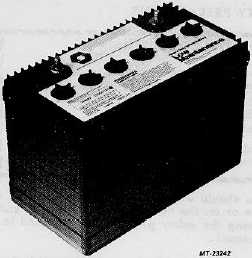|
| |
TRUCK SERVICE MANUAL
TM 5-4210-230-14&P-1
BATTERY CHARGING PRECAUTIONS
Do not attempt to charge a battery unless you are thoroughly
familiar with the step by step procedure to use. Follow the
manufacturer's instructions on the charger. If the instructions
are no longer legible and you do not have literature containing
the instructions, obtain them from the manufacturer of the
charger. Never use a charger without instructions.
The room or compartment in which the battery is being
charged should be well ventilated. Follow precautions to
prevent battery explosion. Explosive mixtures of hydrogen
gas are being generated during battery charging. This gas
can be exploded by a torch, match flame, lighted cigarette,
sparks from loose connections or metal tools making contact
between the terminals or the ungrounded terminal and
adjacent metal parts which are grounded.
Always shield eyes when working around the battery
.
It is recommended that filler caps, where used, be left on the
battery during charging. Additionally, a wet cloth should be
placed over the battery and vent.
DO NOT ATTEMPT TO CHARGE A FROZEN BATTERY.
Allow the battery to warm to 15.5° C (60° F) before placing on
charge.
Always turn the charger to the "OFF" position before
connecting the leads to the battery. If you have any doubts
that the charger is actually "OFF", disconnect it from the
power source.
Never break a "live" circuit at the battery terminals or touch
the charger leads when the charger is "ON". This could create
a spark which could ignite the explosive gases in the battery.
Always turn the charger "OFF" before removing a charger lead
from the battery.
EMERGENCY STARTING PRECAUTIONS
Each step in the procedure outlined under EMERGENCY
(JUMPER) STARTING must be followed with extreme care to
avoid (1) bodily injury due to a gush of electrolyte through the
vents, (2) bodily injury of damage to the vehicles due to
explosion of one of the batteries, or (3) damage to the
electrical system of either or both vehicles.
Wear safety glasses. Never lean over the battery during the
starting operation. Follow precaution to avoid making a spark
or bringing a flame near the battery.
Fig. 1 Low Maintenance (Conventional) Battery
DESCRIPTION
The storage battery is an electro-chemical device. It stores
chemical energy which can be released as electrical energy.
When the battery is connected to an external load such as a
starter, the chemical energy is converted into electrical energy
and current flows through the circuit.
The three main functions of the automotive battery are to:
1. Supply power to the starter and ignition system so the
engine can be cranked and started.
2. Supply the extra power required when the vehicle's
electrical load requirements exceed the supply from the
charging system.
3. Act as a voltage stabilizer in the electrical system. The
battery smoothes out or reduces temporarily high
voltages (transient voltages) which occur in the vehicle
electrical system. This could occur in making or breaking
a circuit, etc. These excessively high voltages would
damage other components in the electrical system if it
were not for the protection provided by the battery. The
battery partially absorbs and greatly reduces these peak
voltages and protects components such as diodes from
being damaged.
"Fleetrite" and "International" batteries are available in
conventional
(low
maintenance)
type
(Figure
1)
and
maintenance free type (Figure 2) as described herein.
CTS-2771 Page 4
PRINTED IN UNITED STATES OF AMERICA
|

